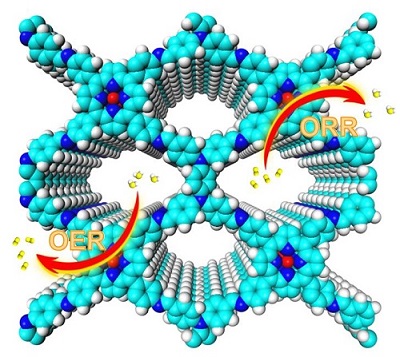Research Progress
It is essential to develop bifunctional oxygen electrocatalysts which exhibit high activity for oxygen reduction reaction (ORR) and oxygen evolution reaction (OER).
Covalent organic frameworks (COFs), which possess ordered pores and high-precision functionalization, have been used in electrochemical energy and conversion systems because of their fast ion transport channels and well-defined electrochemical active sites.
However, the limited electron transport ability along the frameworks hindered their electroactivities, while the development of active sites in COFs towards ORR and OER is rarely explored.
Recently, a research team led by Prof. ZENG Gaofeng and Associate Prof. XU Qing at the Shanghai Advanced Research Institute (SARI) of the Chinese Academy of Sciences constructed a novel bifunctional COFs towards ORR and OER by combining redox-active units with catalytic centers in the frameworks. The COFs showed higher catalytic activities than that of the COF without redox-active units, with a halfwave potential of 0.80 V towards ORR, and an overpotential of 420 mV for OER in 0.1 M KOH, respectively.
The research results were published in Angewandte Chemie International Edition on Oct. 14.
Two novel COFs (CoTAPP-PATA-COF and CoTAPP-BDTA-COF) have ordered structure, high surface area and stable chemical stability. The diamine unit, as a typical electron donor and redox-active core, facilitates the electron transport along the framework and improves the electrochemical active surface area.
The theoretical calculation results demonstrate that the introduction of diamine units can effectively improve the oxygen electrocatalysis. By tuning the catalytic centers, the CoTAPP-PATA-COF catalyzes the ORR and OER with high activity and stability.

Catalytic covalent organic frameworks with bifunctional roles in oxygen reduction reaction (from O2 to H2O) and oxygen evolution reaction (from H2O to O2) have been first demonstrated by integrating redox-active sites into the Co-porphyrin frameworks (Image by SARI)





